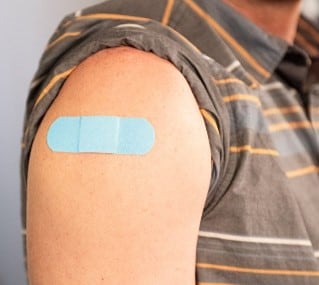What to know
- Talk to a healthcare provider to learn if the mpox vaccine is recommended for you.
- Avoid direct or skin-to-skin contact with people who have a rash that looks like mpox.
- Don't use objects or materials a person with mpox has used.
- Avoid wild animals in areas where mpox occurs regularly.
- Wash hands often and learn steps to lower your risk of mpox during sex or at social gatherings.

Prevention steps and strategies
Get vaccinated!

- The JYNNEOS vaccine is recommended for prevention of mpox. Getting both doses provides the best protection. You should get two doses 4 weeks apart.
- Even if it has been longer than 4 weeks since you got the first vaccine dose, you should get the second dose as soon as possible.
- If you are a close contact of someone who's been diagnosed with mpox, you should get vaccinated as soon as possible after exposure to someone with mpox. Get vaccinated if you were exposed less than 14 days ago, ideally within 4 days, for the best chance to prevent the disease or make it less severe if you do get mpox.
- If you previously recovered from mpox, you do not need the vaccine.
- Check with your healthcare provider if the mpox vaccine is recommended for you.
- Contact your healthcare provider, local pharmacy, or local health department for mpox vaccine availability.
Lower your risk of mpox during sex or at a social gathering
- If you are at risk for mpox but haven't received your two-dose vaccine yet, consider temporarily changing activities that involve close personal contact (such as sex).
- Avoid any rash you see on others and consider minimizing skin-to-skin contact. This is particularly important at a rave, party, or club where there is minimal clothing and where there is direct, personal, often skin-to-skin contact.
- Condoms (latex or polyurethane) may protect your anus (butthole), mouth, penis, or vagina from exposure to mpox. However, condoms alone may not prevent all exposures to mpox since the rash can occur on other parts of the body.
- Learn more about safer sex, social gatherings, and mpox.
Avoid close, skin-to-skin contact with people who have a rash that looks like mpox and animals that carry the virus
This might include skin with what appears to be a rash, pimples, blisters, or scabs.
- The rash might appear on the hands, feet, chest, face, or mouth and other areas like on the genitals (penis, testicles, labia, vagina). Do not touch the rash or scabs of a person with mpox.
- Do not kiss, hug, cuddle, or have sex with someone with mpox.
- Avoid direct contact with someone who may have mpox, including kissing, hugging, and massage.
Avoid contact with animals where mpox occurs regularly
- In areas where mpox is endemic (found regularly), particularly in Central or West Africa, avoid contact with live or dead wild animals that can carry the virus that causes mpox, such as rodents and primates. Direct contact with infected animals can spread the virus.
Avoid contact with objects and materials that a person with mpox has used
- Do not share eating utensils, dishes, plates, or cups with a person with mpox.
- Do not handle or touch the bedding, towels, or clothing of a person with mpox.
- If you or someone you live with has mpox, follow steps for Cleaning and Disinfecting your Home.
Wash your hands often.
- Wash your hands often with soap and water, or use an alcohol-based hand sanitizer, especially before eating or touching your face and after you use the bathroom.
- Handwashing is one of the best ways to protect you, your family, and your friends from getting sick.
When to visit a healthcare provider
Watch for symptoms of mpox for 21 days from the date of your last exposure. If you have symptoms, such as a rash, visit a healthcare provider.
